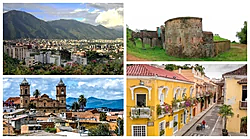Cortez
| Cortez Municipio de Cortés | |||
|---|---|---|---|
| Regional capital | |||
 Clockwise from top left: downtown Cortez with Las Montañas Trillizas visible in the background, remnants of the city walls of Old Cortez at Capa Mirador, San Cristobal Cathedral in the Old Quarter and a quiet street in Mercado del Bígaro | |||
| |||
| Motto(s): "Somos las raíces que dejan florecer las flores" (We are the roots that let the flowers bloom) | |||
| Anthem: A Media Mañana en Cortés | |||
| Department | La Mosquitia | ||
| Established | 1581 | ||
| Named for | Hernán Cortés | ||
| Government | |||
| • Type | Municipality | ||
| • Mayor | Giancarlo Esteban San Lucas Pedalmo (APSD) | ||
| Area | |||
| • Total | 497 km2 (192 sq mi) | ||
| Elevation | 233 m (763 ft) | ||
| Population | |||
| • Total | 912,530 | ||
| Time zone | CST (UTC-6) | ||
| Area code(s) | 227 | ||
| ISO 3166 code | CZ | ||
Cortez (/kɔːrˈtɛs/), known as Cortés in the Spanish language, is the largest city in Berima and the fourth largest city in Central America. It has served as a historical capital for Berima throughout the centuries and is also currently the capital of the Berriman Province of Cortez. It is located on the northeastern coast of La Mosquitia on the banks of the Coco River and has been continuously permanently settled for over four centuries (although the land around it has been inhabited by various indigenous peoples since before recorded history). It was originally founded as a Spanish mission in the late sixteenth century with the express purpose of introducing facets of Spanish civilization to the indigenous Miskito populace. Its geographical location is prime as it sits directly on a major river and is surrounded by Las Montañas Trillizas which effectively separate it from the rest of Berima and have provided a historically nearly impenetrable natural barrier against land based invasions. Cortez also serves as an important transit hub in Berima as well as the focal point of the countries economic activity. The official population according to the 2015 census is 912,530 which places it just behind Guatemala City. The city is named after the anglicized version of the name of Spanish conquistador Hernán Cortés which was put in place by the Spanish missionaries that originally founded the settlement.
Founded in 1581, Cortez has served as the capital of Berima three times. It has never been invaded by an opposing force despite attempts by the Spanish, British, American, and Nicaraguan governments. Considered the most historically and culturally relevant city in Berima, Cortez today is the unofficial economic, industrial, and cultural capital of the nation. The population of Cortez is largely Mestizo but a large minority of indigenous and black populations exist in specific sections of the city.
Host to many of Berima's notable landmarks and largest international airport, Cortez is a bustling metropolis and serves as the mecca of Berima's tourism industry, with over 1 million visitors passing through the city every day. The city is also host to the majority of Berima's museums, botanical gardens, and universities. Various historical sites dot the landscape as well with remnants of the original Spanish colony still being excavated to this day and the some sections of the city walls built in the seventeenth century still stand to this day. The historical site at Capa Mirador and the San Cristobal Cathedral have both been designated as UNESCO World Heritage sites and Trillizas National Park borders the city on two sides.
Cortez is notable for its high standard of living among other large Latin American cities. It ranks among the highest in public safety, globalization, environmental sustainability and public service in Latin America. Considered one of the safest cities in Central America, Cortez has one of the fastest growing economies on the isthmus and is considered a global "Beta-" city by the GaWC. Recently Berima has made a bid to host the 2026 World Cup with the newly built Stadiodrome complex in downtown Cortez serving as the primary playing field.

